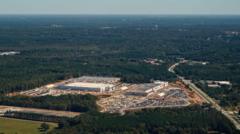Beverly Morris thought she had found her tranquil retirement haven in Fayette County, Georgia, back in 2016. Just a stone's throw from her home, however, stands a massive data center owned by Meta, the parent company of Facebook. Now, instead of peace, Morris grapples with serious water issues.
"I can't drink the water," she laments, explaining that the construction of the center appears to have disrupted her private well, resulting in sediment build-up. Morris reports that the water pressure in her home has dwindled significantly, forcing her to haul buckets of water just to flush the toilet. Despite her attempts to resolve the issue, she hesitates to drink from the tap – a situation she describes as unnerving.
Meta has refuted any connection between its facilities and Morris's water problems, claiming to prioritize neighborhood welfare. The company conducted an independent groundwater study which concluded their operations did not negatively impact local water conditions. Nonetheless, this does not ease Morris's distress, as she feels the presence of the data center has disrupted her once-ideal living situation.
Across the United States, data centers—physical structures that power various online services—are proliferating in response to the demand driven by AI and digital activities. With more people expressing concerns about the environmental impact of these centers, local activism is on the rise. An advocacy group has reported that projects worth $64 billion have faced delays due to pushback from affected communities.
Georgia is notable for its rapidly growing data center market. Its climate offers a natural cooling source, but the water demands of these facilities are staggering. To keep servers operational, data centers often use vast amounts of water, with some estimates predicting AI-centric centers could consume 1.7 trillion gallons globally by 2027.
Gordon Rogers, executive director of Flint Riverkeeper, highlights the impact of nearby data center construction. Water quality sampling has revealed troubling signs, such as cloudy, brown water that may suggest environmental pollutants linked to runoff from construction activities. Local advocacy asks for stricter regulations to protect water resources, while companies argue they adhere to environmental standards and contribute economically to local communities.
Tech companies, like Amazon, are cognizant of scrutiny over water usage. They aim to restore more water to local watersheds than they consume by 2030. Innovations such as rainwater harvesting and efficient cooling methods are on the agenda, but as AI demand surges, the pressure on water resources remains high.
Despite the industry's advancements towards sustainability, residents like Morris are left in limbo, between a cherished dream home and a looming tech infrastructure. As data centers entwine with communities, the challenge persists: how to sustain the digital future without exhausting the essential resource of water.


















